Remedying our planet’s greatest risks
Few forecasters would value ‘wisdom of hindsight’ more than those responsible for identifying and assessing risk. As little as six months ago, the term coronavirus was known to hardly anyone outside scientific and medical circles. The now-ubiquitous image of a spheroid virus with protruding protein spikes was yet to imprint itself on the global consciousness.
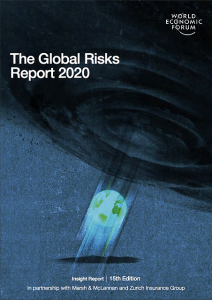 As a graphic demonstration of risk’s elusive nature, when the World Economic Forum (WEF) published its annual Global Risks Report 2020, in January this year, there was little mention of pandemics – let alone COVID-19.
As a graphic demonstration of risk’s elusive nature, when the World Economic Forum (WEF) published its annual Global Risks Report 2020, in January this year, there was little mention of pandemics – let alone COVID-19.
This was despite the fact the virus was already spreading from continent to continent and had been identified as a likely zoonotic (and highly contagious) disease within its original epicenter.
Regardless of previous virus scares around SARS in 2002 and MERS in 2012, the danger posed by pandemics and infectious diseases failed to make the list of the top ten global risks (in terms of likelihood to occur) identified by the WEF in January’s report. Indeed, pandemics and infectious diseases have failed to rank among the WEF’s top five risks for the past decade, despite experts in the field fearing an outbreak was potentially overdue.
None of which is to criticize the WEF. On the contrary, the WEF could actually be hailed for its foresight, since its earlier Global Risks Report of 2019 included a special investigation into ‘biological risks’ a full 12 months before COVID-19 made itself known.
Tellingly, its 2019 risk report noted that:
- The World Health Organization (WHO) felt it prudent to include a ‘Disease X’ in its list of infections warranting most urgent research – an acknowledgment that future unknown pathogens are as dangerous as those already on our radar
- Countries remained gravely unprepared for pandemics, with most failing to meet minimum international standards for detecting and reporting public health threats, as per binding regulations dating back to 2007[1]
- The WHO’s Contingency Fund for Emergencies (established in 2015 to provide rapid responses for health crises) was funded to only one-third of its US$ 100 million target
- The international system for sharing biological samples, so crucial for disease response, had been weakened by the Nagoya Protocol, potentially offering nations greater rights to samples collected in their own territory.
Much of which now sounds deeply prophetic. But at the time barely raised an eyebrow.
By the time of this year’s WEF report, the top five risks (in descending order of likelihood) were in fact extreme weather, climate action failure, natural disasters, biodiversity loss and human-made environmental disasters. On the surface, these risks do not seem to have much relation to a virus pandemic. But actually, some of them are more relevant to coronavirus than they first appear.
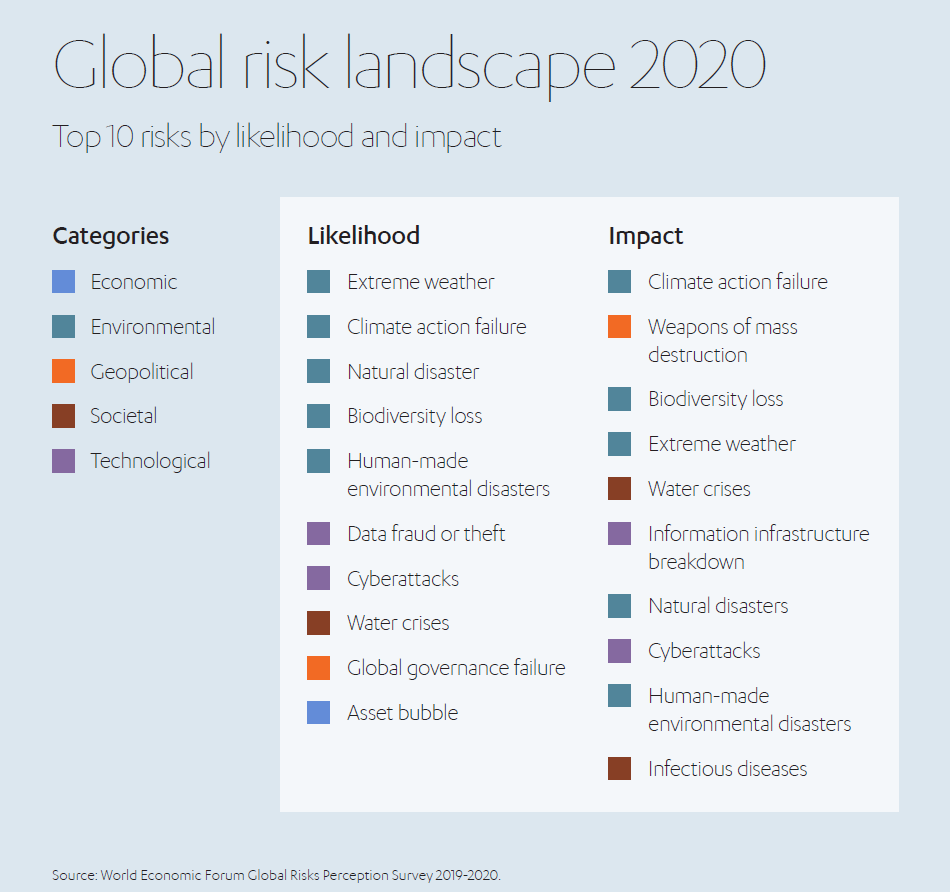
Environment and epidemiology are forever interlinked
The 2020 WEF risk report could be more prescient than a superficial read suggests. Why?
Humankind is front and center in the chain of events that led to COVID-19. Our industries, our cultures, our exploitation of the environment, our sheer numbers, are all frequently cited as instrumental to the viral outbreak. Slowly but surely, we have inadvertently created an environment that is ripe for the emergence new viruses and primed for their rapid dispersal to all four corners of the globe.
As Fady Jameel, Deputy President and Vice Chairman, Abdul Latif Jameel, insightfully explained in a previous Insights article, in a world without our environmental mismanagement, it is hard to imagine coronavirus emerging, let alone becoming so rife that it brings society as we know it to a halt.
Looking again at those risks identified by the WEF, the top five (identified by likelihood) are all directly or indirectly linked to the environment.
- Extreme weather. More than 77% of respondents to the WEF report (academics, governments, businesses and NGOs) believe the dangers of extreme heatwaves will increase in 2020[2]. The same survey reveals that extreme weather in general is deemed the most likely long-term risk over the next decade. The fear is justifiable. Tropical Cyclone Idai left almost 150,000 people homeless after bringing chaos to Africa and the southern hemisphere in 2019. Overall, some 20 million people were forced to leave their homes due to storms, floods, fires and heat between 2008 and 2016.
- Climate action failure. The evidence is overwhelming: rapid and unprecedented climate change is being hastened by the activities of humankind. In 2018 global mean sea levels reached about 20 cm higher than at the beginning of the 20th Century[3]. Despite our knowledge of the dangers of greenhouse gases, between 1990 and 2010, such emissions rose everywhere in the world except for Europe, led by Asia’s 95% rise[4]. Continuing along our current track, global temperatures will rise by a disastrous 3-6°C by 2100 – and at least 2°C even if emissions peak before 2030[5]. “The near-term impacts of climate change add up to a planetary emergency that will include loss of life, social and geopolitical tensions and negative economic impacts,” the WEF states[6].
- Natural disasters. Despite the categorization of natural, few doubt that many disasters of this kind – droughts, flooding, heatwaves, etc – are at least exacerbated by human activity. A report for the IMF identifies a record 8,000 weather related disasters between 1990 and 2014[7]. Higher temperatures are associated with droughts, wildfires, heatwaves and storms; more rainfall is associated with floods, landslides and tropical cyclones.
- Biodiversity loss. Some 75% of Earth’s land surface and 66% of its oceans and seas have been significantly altered by human actions, according to the Intergovernmental Science-Policy Platform on Biodiversity and Ecosystem Services (IPBES) [8]. More than a third of the world’s land, and nearly three-quarters of freshwater environments, are now devoted to crops or livestock. Soil degradation has reduced the productivity of 23% of the global land surface. As the WEF notes, the current rate of extinction “is tens to hundreds of times higher than the average over the past 10 million years – and accelerating. Biodiversity loss has critical implications for humanity, from the collapse of food and health systems to the disruption of entire supply chains.” [9]
- Human-made environmental disasters. Ever since intense plowing of soil in the American Great Plains caused the US ‘dust bowl’ crisis of the 1930s (costing hundreds of thousands their homes and livelihoods), humankind has grossly mismanaged the environment through short-term exploitation. Now we have hazards such as oil spills (e.g. Exxon Valdez in 1989 or Deepwater Horizon in 2010), radioactive leaks (e.g. Chernobyl in 1986) and contamination of water supplies (e.g. the Flint water crisis of 2013) in addition to naturally-occurring disasters. The cost in human terms is self-evident, but there is also a measurable financial impact. In its Words Into Action: Man-made and Technological Hazards report, the UN Office for Disaster Risk Reduction estimated the economic impact of man-made disasters in 2016 alone to be US$ 9 billion[10].
Three of the above risks (extreme weather, climate action failure and biodiversity loss) are categorized by the WEF report not only as the risks most likely to transpire, but also the most potentially impactful – an intersection of plausibility and harm that should put us on our guard.
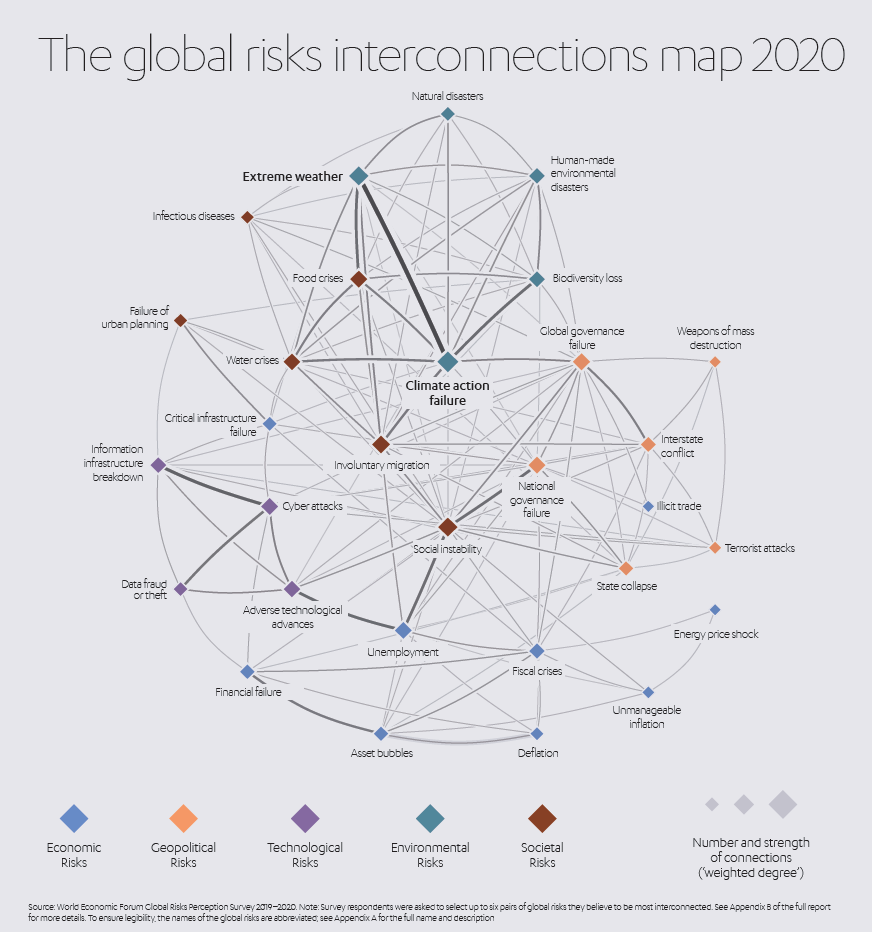
Perversity of pathological risk-taking
Our society must look in the mirror and assess how our behaviors are driving global risk – particularly for zoonotic diseases (that is, diseases that pass from animals or insects to humans).
Rainforests are destroyed, habitats altered, weather patterns changed, water and food systems are compromised. These actions are doubly short-sighted, firstly encouraging the emergence of zoonotic diseases, and then increasing human-animal interactions as habitats disappear. The outcome is as inevitable as it is tragic.
Just how dangerous is this game of baiting pathogens?
In a 2016 report, the UN Environment Programme (UNEP) reported that 75% of new diseases affecting people over the previous 10 years was zoonotic, and that a new infectious disease emerged in humans, on average, every four months[11].
We would do well to consider how the dangers of environmental desecration and disease are interwoven and start reshaping our societies to deter the kind of threats currently dominating headlines.
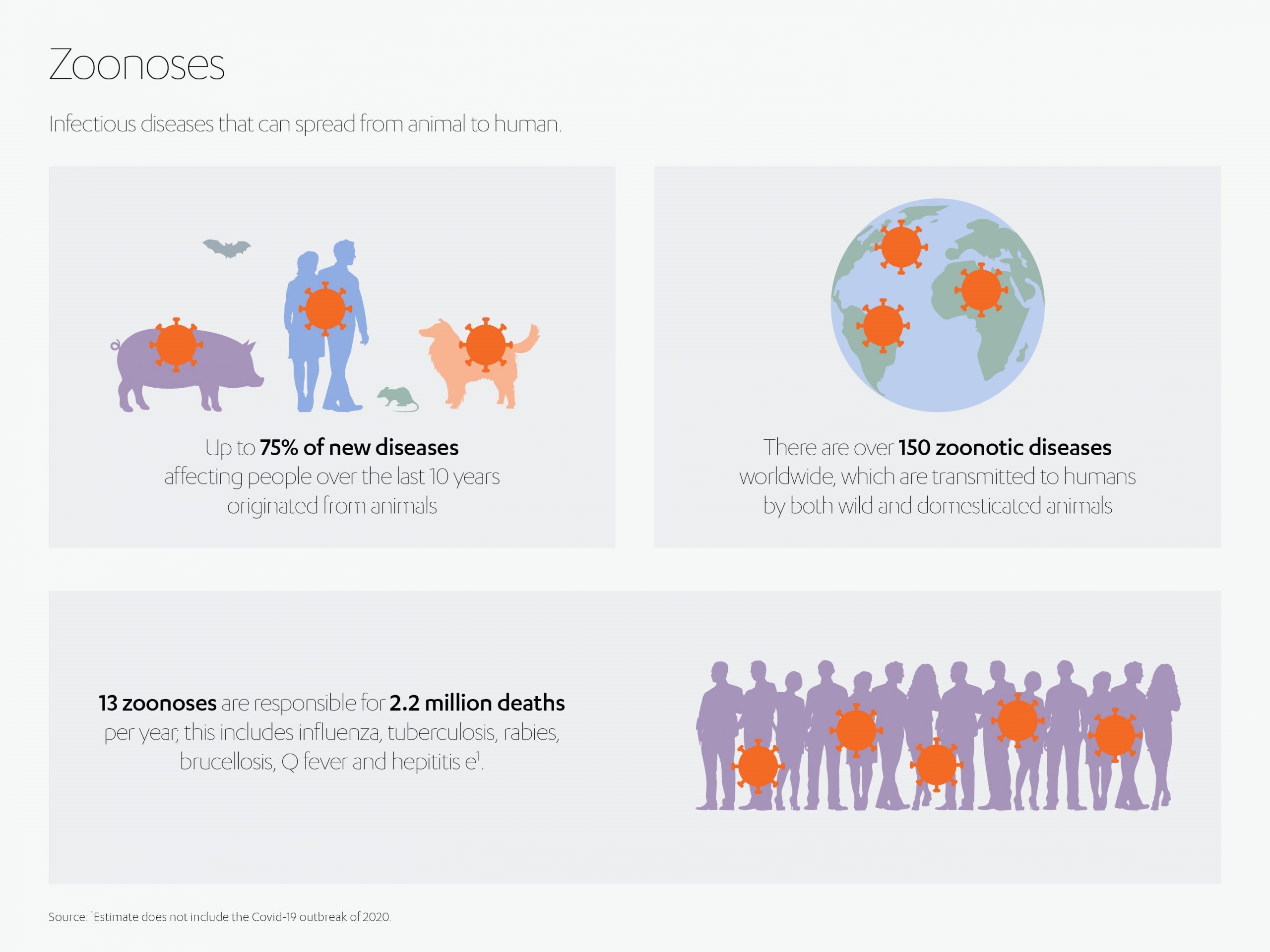
After all, it is impossible to downplay the devastation brought upon the world by the outbreak of COVID-19. At time of writing, there have been more than 8 million confirmed cases and almost 445,000 deaths across 188 countries, according to WHO figures. North America alone has witnessed in excess of 2.1 million cases and over 110,000 fatalities[12].
The economic picture is equally stark. As of the start of May, the Dow Jones had fallen 18.5% since the outbreak was confirmed, the Nikkei 14.7% and the FTSE 100 24.5% – the biggest first-quarter drops in more than 30 years. The US Senate was compelled to pass a US$ 2 trillion aid package after more than 30 million Americans filed for unemployment benefits in a single six-week period. The price of crude oil dropped below US$ 20 a barrel, its lowest in 18 years[13].
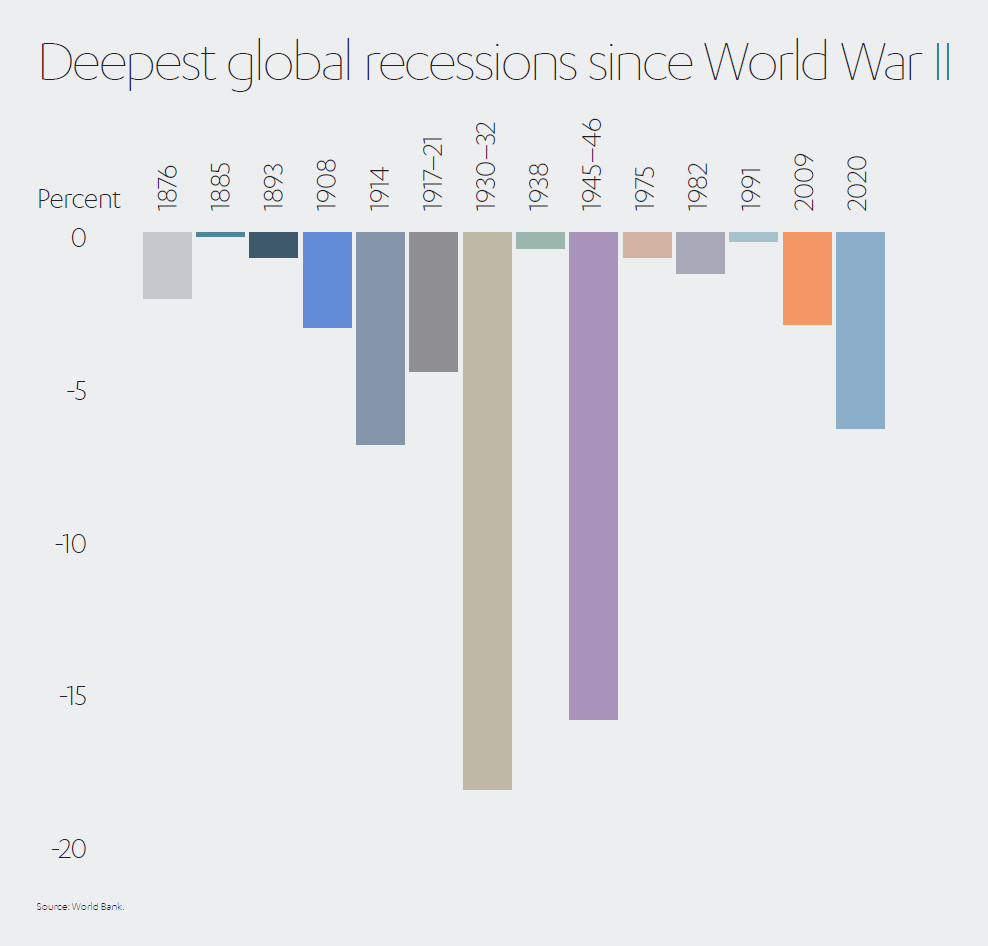
According to the World Bank, the global economy has experienced 14 global recessions since 1870: in 1876, 1885, 1893, 1908, 1914, 1917-21, 1930-32, 1938, 1945-46, 1975, 1982, 1991, 2009, and 2020.
The COVID-19 recession will be the deepest since 1945-46, and more than twice as deep as the recession associated with the 2007-09 global financial crisis.
It is perhaps even more concerning when you consider that in terms of ‘impact’ (as opposed to ‘likelihood’) infectious diseases ranked only tenth in this year’s WEF Global Risks Report [14]. Other environment-linked risks were seen as having the potential for even greater global consequences, which suggests we could have found ourselves in even deeper trouble.
Wake-up call to the reality of risk
Climate action failure. Biodiversity loss. Extreme weather. Water crises. Natural disasters. Human-made environmental disasters. At the start of this year, each of these eventualities was considered to have an even greater impact potential than the pandemic we now find ourselves enduring.
Perhaps coronavirus is the final warning bell for us to accept the urgency with which we need to respect and protect our planet.
Such a reaction would be long overdue, given the damning statistics of recent years. Like the 1.3 million square kilometers of forest that were lost from 1990 to 2016[15]. Or the 32% increase in aviation CO2 emissions between 2013 and 2018[16]. Or that with just a 2°C rise in temperatures, virtually all coral reefs will vanish by 2100 and ice-free Arctic summers will become common[17]. This, despite the UN’s Emissions Gap Report of 2019 warning that greenhouse gases need to fall 7.6% annually to limit future global warming to 1.5C[18].
But even these depressing figures were not enough. It took a coronavirus-style crisis to make us realize how helpless we are in the face of greater forces – how we are not remote observers of the ecosystem, but it is entwined with our very DNA.
If there are any positives to come out of this situation, it must be that our society finally finds the commitment, determination and investment to start tackling climate change in a meaningful, sustainable way. If not, we could find ourselves easy prey for any or all of the risks outlined in the WEF’s risk report.
Turning risk to our advantage
Risk isn’t just there to scare us, but to guide us. Mitigating many of these risks, pandemics included, will involve establishing a new relationship with the natural environment. There is growing acknowledgement that future-proofing our civilization will require a cohesive and global approach.
The Abdul Latif Jameel organization has long understood the social responsibility of its businesses operations when it comes to safeguarding the World for subsequent generations. Managing risks is central to this goal.
It has a long-standing commitment to investing in the ‘infrastructure of life’. Across the 30 or so countries where Abdul Latif Jameel is now active, it has major investments in solar power, wind power, water solutions and environmental services. Its energy portfolio encompasses some 2 GW of power across multiple sites, offsetting a larger share of fossil fuels year by year.
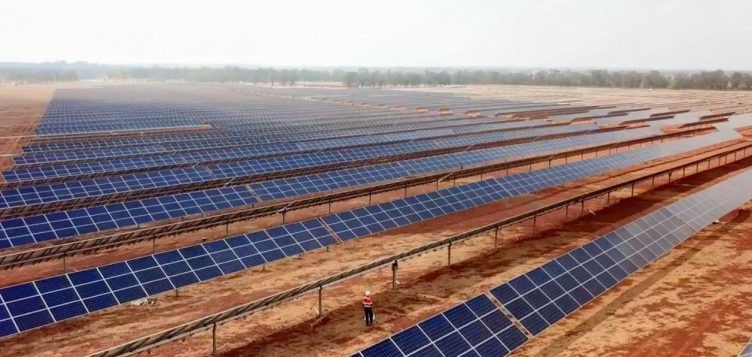
Apart from helping to drive the transition to a more sustainable economy and mitigate climate change in the process, the family’s global philanthropy, Community Jameel, it is also helping to drive research, innovation and investment to improve global food and water systems, indirectly addressing some of the very problems that have created an environment where pathogens like coronavirus can prosper.
 The Abdul Latif Jameel Water and Food and Systems Lab (J-WAFS) at Massachusetts Institute of Technology (MIT), supports research, innovation and technology to ensure safe, resilient food and water supplies with minimal environmental impact.
The Abdul Latif Jameel Water and Food and Systems Lab (J-WAFS) at Massachusetts Institute of Technology (MIT), supports research, innovation and technology to ensure safe, resilient food and water supplies with minimal environmental impact.
Since its founding in 2014, it has funded more than 60 projects, generating more than US$ 12 million in follow-on funds to extend and expand their J-WAFS research[19].
Much of the research that J-WAFS supports is based around the search for breakthrough innovative techniques to improve, and ideally transform, the efficiency and effectiveness of food and water systems in developing countries at a cost that makes them accessible and economically viable.
Similarly, in the field of global health and wellbeing, Abdul Latif Jameel supports two labs at the cutting edge of research. In 2019, the global philanthropy, Community Jameel partnered with Imperial College London to co-found J-IDEA, the Abdul Latif Jameel Institute for Disease and Emergency Analytics.

The Jameel Institute brings together world-leading expertise in research, data analytics and epidemiology to improve our understanding of diseases and health emergencies in the most vulnerable populations across the globe and has been at the forefront of research and modelling in the current pandemic.
J-IDEA complements the work of Community Jameel’s other global health collaboration, the Jameel Clinic, the Abdul Latif Jameel Clinic for Machine Learning in Health. Co-founded in 2018 in partnership with the Massachusetts Institute of Technology (MIT), J-Clinic explores how AI can prevent, detect and treat debilitating conditions such as cancer, sepsis, dementia and other neurological disorders.
 In February 2020, J-Clinic announced the discovery of a powerful new antibiotic compound using a machine-learning algorithm. The drug killed many of the world’s most problematic disease-causing bacteria in laboratory tests, including some strains that are resistant to all known antibiotics.
In February 2020, J-Clinic announced the discovery of a powerful new antibiotic compound using a machine-learning algorithm. The drug killed many of the world’s most problematic disease-causing bacteria in laboratory tests, including some strains that are resistant to all known antibiotics.
Where next? Concluding thoughts from Fady Jameel.
“Through our business portfolio and Community Jameel activities we continue to contribute in the right direction for nurturing a more sustainable, more resilient world,”
says Fady Jameel, Deputy President and Vice Chairman, Abdul Latif Jameel – a long-time advocate of addressing the global climate crisis.

Fady Jameel, Deputy President & Vice Chairman, Abdul Latif Jameel
“The recent pandemic has caught everyone’s attention, overturning our accepted ways of life. However, what it has taught us is the potential of any environmental emergency to paralyze societies.”
“This knowledge, although a painful experience, could be turned into a great asset. By its very nature, risk will always remain somewhat opaque; its potency lies in its ability to surprise. I hope that an approach that tackles the underlying fundamental problems, such as the man-made causes of climate change and environmental degradation – and more importantly doing this together, from individuals in our daily lives to business and both government policy and international collaboration – we can emerge from this situation, perhaps a little more humble, but stronger and wiser, than before.”
[1] https://www.who.int/bulletin/volumes/85/6/07-100607/en/
[2] http://www3.weforum.org/docs/WEF_Global_Risk_Report_2020.pdf
[3] https://www.eea.europa.eu/data-and-maps/indicators/sea-level-rise-6/assessment
[4] https://www.oecd.org/environment/cop21-climate-change-in-figures.htm
[5] https://www.oecd.org/environment/cop21-climate-change-in-figures.htm
[6] http://www3.weforum.org/docs/WEF_Global_Risk_Report_2020.pdf
[7]https://www.imf.org/en/Publications/WEO/Issues/2017/09/19/~/media/Files/Publications/WEO/2017/October/pdf/analytical-chapters/c3.ashx
[8] https://www.un.org/sustainabledevelopment/blog/2019/05/nature-decline-unprecedented-report/
[9] http://www3.weforum.org/docs/WEF_Global_Risk_Report_2020.pdf
[10] https://www.preventionweb.net/files/54012_manmadetechhazards.pdf
[11] https://environmentlive.unep.org/media/docs/assessments/UNEP_Frontiers_2016_report_emerging_issues_of_environmental_concern.pdf
[12] https://covid19.who.int/region/amro/country/us
[13] https://www.bbc.co.uk/news/business-51706225
[14] http://www3.weforum.org/docs/WEF_Global_Risk_Report_2020.pdf
[15] https://www.nationalgeographic.com/environment/global-warming/deforestation/
[16] https://theicct.org/sites/default/files/publications/ICCT_CO2-commercl-aviation-2018_20190918.pdf
[17] https://www.ipcc.ch/2018/10/08/summary-for-policymakers-of-ipcc-special-report-on-global-warming-of-1-5c-approved-by-governments/
[18] https://www.unenvironment.org/interactive/emissions-gap-report/2019/





 1x
1x

 Added to press kit
Added to press kit


